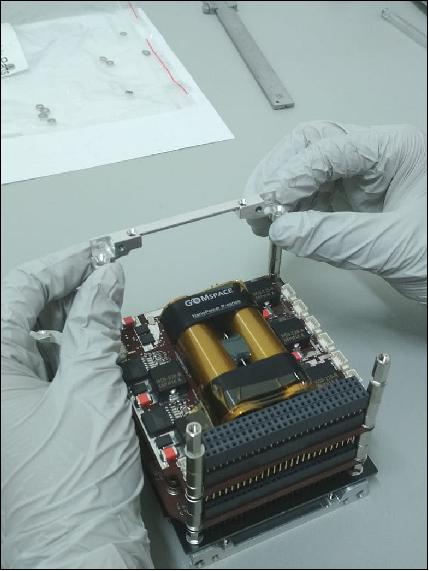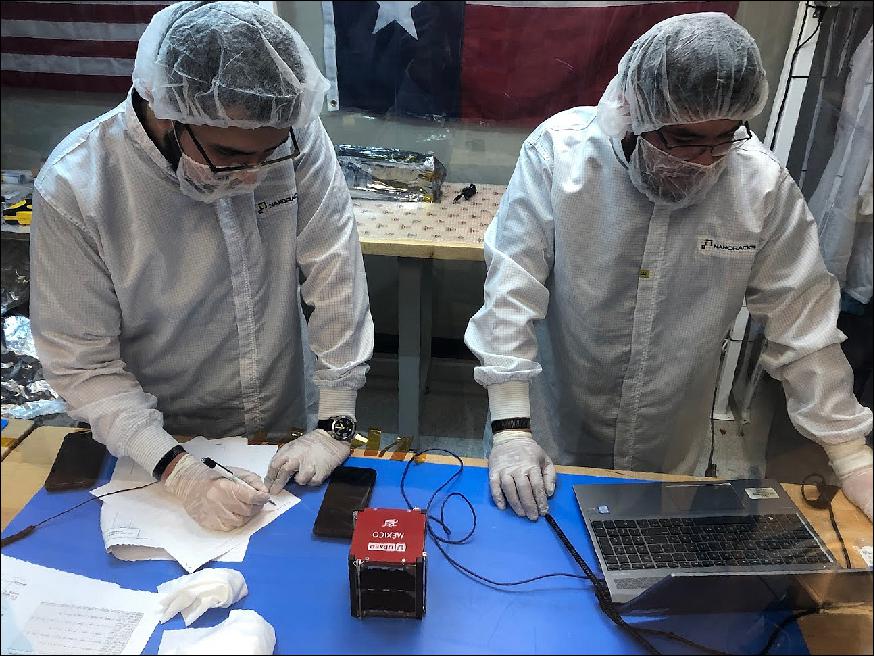AzTechSat-1 CubeSat
Non-EO
NASA
Education
Technology and Research
Quick facts
Overview
| Mission type | Non-EO |
| Agency | NASA |
| Launch date | 05 Dec 2019 |
AzTechSat-1 CubeSat
A multidisciplinary team of students at Universidad Popular Autónoma del Estado de Puebla (UPAEP), in Puebla, Mexico, built the 1U CubeSat for AzTechSat-1. The investigation demonstrates communication within a satellite network in low-Earth orbit. Such Intra-satellite communication could reduce the need for ground stations, lowering the cost and increasing the number of data downloads possible for satellite applications. 1)
The project is part of NASA's CubeSat Launch Initiative, which offers universities, high schools and non-profit organizations the opportunity to fly small satellites. Innovative technology partnerships keep down the cost, providing students a way to obtain hands-on experience developing flight hardware.
"For UPAEP to be the pioneer university working with NASA and launching the first Mexican nanosatellite from the space station is a point of great pride," said UPAEP faculty member Erika del Carmen Sevilla García. "It motivates students to believe in themselves and exploit their capabilities to the fullest."
Background
An international collaboration program for capacity building in space technology is being established between NASA and the Mexican Space Agency (AEM). Its objective is to develop a series of CubeSats collaboratively in a way that benefits both agencies. For AEM, this experience will support the development of human capital required for its space program. This project provides an opportunity for NASA future missions to benefit from commercially available technologies demonstrated in space. AEM was recently created by the Mexican Government to use and develop space technology in Mexico. Current AEM plans call for having the capability of developing its own communication satellites by 2030, so the need for having a Mexican cadre of space experts is mandatory.
The program will start with the development and launching of AztechSat-1, the first AEM CubeSat project to be deployed from the International Space Station (ISS). Several public Mexican universities will participate in this project to demonstrate GlobalStar, a satellite communications provider using a constellation of LEO satellites, as an option for small satellite missions.
The AztechSat-1 mission objectives are:
• Develop a flight ready CubeSat for deployment from the ISS
• Demonstrate GlobalStar´s Network as a method to advance communications in CubeSat missions.
AztechSat-1 is envisioned as a 1U CubeSat and will be designed and constructed by Mexican graduate students from two major universities in Mexico: UNAM and IPN. The students will be mentored and supervised by researchers from NASA Ames Research Center (NARC). Flight acceptance tests are going to be done both at Mexican university labs as well as at NARC. Funding for the project will be provided concurrently by AEM, the Mexican participating universities, and other Mexican entities.
The development of AztechSat-1 will emphasize the transfer of knowledge in space mission analysis and design, flight acceptance testing and other areas of space technology which are not well developed in Mexico yet. Mexican students will benefit from their mentoring from NASA researchers and will provide a multiplier effect in the development of the next generation of Mexican aerospace engineers.
AztechSat-1 will be developed in a period of twelve months and will be launched by late 2015. AztechSat´s success will define the future of collaboration between NASA and AEM in capacity building. A plan for developing a series of AztechSat's in a one per year basis, with increasing capabilities and complexity is currently being negotiated between NASA and AEM.
Francisco Fernando Eugenio Urrutia Albisua, a vicerector or vice president at UPAEP, pointed out that the program is important for the university and for the country. "For Mexico, I hope this will lead to future research and telecommunications projects involving universities or new emerging companies. For UPAEP, it is an honor to be the first university in Mexico to design and build a nanosatellite for flight on the space station."
According to UPAEP faculty member Maria de la Luz Garcia Cruz, the high-level project represents the start of a new era in Mexico. It also provides inspiration and teaches valuable skills to the students, teachers, and scientists involved.
"For a project such as building a nanosatellite, teamwork is crucial," said student team member Rosa Reyna Gonzalez Cancino. "Everybody's work must be valued and appreciated. Project management is the main step for successfully completing any project, no matter how big or small." An engineering major, she hopes to work on a second AzTechSat mission and eventually seek a job related to satellites or space projects.
The project provided opportunities for students outside of engineering as well. Ana Belen Urrutia Bartsch, a UPAEP student in film and production, is part of a team creating a documentary of the effort. "I learned that big projects like this require a lot of planning and organization time, and a great team of people who work hard on it," she said. She plans to pursue a master's degree in cinematography and work in the film industry in Mexico.
Everyone involved in the project looks forward to seeing it launch from historic Cape Canaveral. "Since I was a kid, space exploration and research represented something very special and exciting," said Eugenio Urrutia. "I never thought to be part of it, even in a modest project like ours."
"The aerospace industry in Mexico is growing in a very important way, but investments are coming mostly from foreign countries," he added. "This nanosatellite shows a way to create a domestic industry to collaborate and compete with companies around the world."
Garcia Cruz notes that the alliances the project created between several academic institutions and private companies provides a path for future projects. "This satellite is promoting the aerospace industry in Mexico."
Spacecraft
AztechSat-1 uses two onboard communication systems: Globalstar Satellite transmitter Integrated Global Positioning System (GPS) Receiver (STINGR) modem and an ultra high frequency/very high frequency (UHF/VHF) amateur band radio. The Globalstar STINGR modem has an embedded L-band radio and a GPS, through which the modem's crosslink communication is a patch antenna. Demonstrating the capability to use the STINGR modem ensures inter-satellite communications is accomplished. The STINGR is a low cost, original equipment manufacturer (OEM) simplex module that sends one-way data messages via the Globalstar Simplex Network. The module includes a high-performance GPS receiver as well as an on-board dual band antenna, greatly simplifying the effort of integrating satellite communications into a tracking or monitoring device. The STINGR is ideal for delivering remote sensing, tracking, and monitoring applications. The STINGR is a simplex satellite transmitter designed to send small user-defined data packets to a low-Earth orbit (LEO) satellite network using the Globalstar simplex satellite network. 3)
Inter-satellite communication is critical to future human space exploration. In addition, its reduced cost and increased data capability could improve many satelliteborne services used by people on Earth. Size may be the only thing small about a CubeSat.
The AzTechSat-1 will promote radio amateur activities such as listening emergency messages in the 439 MHz frequency and processing them via winlink system, listen and transmitting information in the 435-438 MHz, creating antenna equipment, locate the satellite and capture the AzTechSat-1 messages and verify them in our web page www.upaep.mx/aztechsat. 4)


Launch
The AzTechSat-1 1U CubeSat was launched on the SpX CRS-19 (Commercial Resupply-19) Dragon mission to the ISS on 5 December 2019 (17:29:24 UTC). SpaceX launched its CRS-19 mission from Space Launch Complex 40 (SLC-40) at Cape Canaveral Air Force Station, Florida. 5)
Orbit: Near circular orbit, altitude of ~400 km, inclination = 51.6º.
Secondary payloads
The following ELaNa 25B and 28 technology and demonstration missions were launched on this resupply flight.
• AzTechSat-1. A 1U CubeSat technology demonstration developed by UPAEP (Universidad Popular Autonoma del Estado de Puebla) in Puebla, Mexico, that will use the low-Earth orbit satellite constellation Globalstar for satellite phone and low-speed data communications.
• CryoCube-1. A 3U CubeSat developed at NASA/KSC to perform cryogenic fluid management experiments. The 3U Cubesat features deployable solar arrays, which double as a solar heat shield. A second deployable heat shield will block earth's infrared radiation. Active doors will expose the cryogenic oxygen tank to space during eclipse phases.
• SORTIE (Scintillation Observations and Response of The Ionosphere to Electrodynamics). The SORTIE 6U CubeSat mission is led by ASTRA LLC (Atmospheric & Space Technology Research Associates). The team is composed of ASTRA, COSMIAC, AFRL, University of Texas at Dallas and Boston College. COSMIAC will be the satellite integrator. The mission is to collect data over the course of 6 months, which will allow scientists to describe the distribution of wave-like structures in the plasma density of the ionospheric F-region and to connect these variations to wave sources in the troposphere and in the high latitude thermosphere.
• CIRiS (Compact Infrared Radiometer in Space). A 6U CubeSat of USU (Utah State University), Logan, UT. The objective is to raise the technology readiness level of the new uncooled detector and carbon nanotube source from level 5 to 6, enabling future reduced cost missions to study the hydrologic cycle, characterization of ocean/atmosphere interactions vegetation and land use management. The IR radiometer features a spectral range from 7-13 µm.
• EdgeCube. A 1U CubeSat of Sonoma State University. The objective is to take global measurements of the red edge that monitors a sharp change in leaf reflectance in the range 680 - 750 nm from changes in vegetation chlorophyll absorption and mesophyll scattering due to seasonal leaf phenology or stress. The payload consists of six pairs of photo-sensors and filters that are pointed normal to the spin axis to scan the Earth.
Dragon will join three other spacecraft currently at the station. On 8 December (Sunday), ESA astronaut Luca Parmitano and NASA flight engineer Drew Morgan will man the space station's Canadian-built robot arm to capture the Dragon supply ship. The robotic arm will position the Dragon spacecraft on the station's Harmony module, where astronauts will open hatches and begin unpacking the cargo inside the supply ship's internal compartment.
Operations
NanoRacks CubeSats are delivered to the International Space Station (ISS) already integrated within a NanoRacks CubeSat Deployer (NRCSD) or NanoRacks DoubleWide Deployer (NRDD). A crew member transfers each NRCSD/NRDD from the launch vehicle to the JEM. Visual inspection for damage to each NRCSD is performed. When CubeSat deployment operations begin, the NRCSD/NRDDs are unpacked, mounted on the JAXA Multi-Purpose Experiment Platform (MPEP) and placed on the JEM airlock slide table for transfer outside the ISS. A crew member operates the JEM Remote Manipulating System (JRMS) – to grapple and position for deployment. CubeSats are deployed when JAXA ground controllers command a specific NRCSD.
Upon deployment from the ISS, AztechSat-1 is powered on and timers start counting down. After 40 minutes, the antennas are deployed and the AztechSat-1 starts the detumble orientation control. The UHF transceiver is then activated and transmits to Ground Stations around the world. The main mission of AztechSat-1 starts when the onboard computer (OBC) sends the first package with housekeeping information, which is transmitted through the STINGR modem to the Globalstar constellation. The estimated lifetime in space is six months until its decay.
References
1) Melissa Gaskill, Michael Johnson, "Mexican students launch a small satellite to the International Space Station," NASA, 3 December 2019, URL: https://web.archive.org/web/20230628145811/http://www.nasa.gov/mission_pages/station/research/news/aztech-first-mexican-student-satellite/
2) "AztechSat-1, a First Collaborative CubeSat Between NASA and Mexico," NTRS, 3 December 2014, URL: https://ntrs.nasa.gov/archive/nasa/casi.ntrs.nasa.gov/20190001961.pdf
3) "AzTechSat-1," NASA, URL: https://www.nasa.gov/mission_pages/station/research/experiments/explorer/Investigation.html?#id=8055
4) IARU (International Amateur Radio Union) Amateur Satellite Frequency Coordination," 27 May 2019, URL: http://www.amsatuk.me.uk/iaru/finished_detail.php?serialnum=661
5) "SpaceX Dragon Heads to Space Station With NASA Science," NASA News, 5 December 2019, URL: https://www.jpl.nasa.gov/news/news.php?release=2019-239
The information compiled and edited in this article was provided by Herbert J. Kramer from his documentation of: "Observation of the Earth and Its Environment: Survey of Missions and Sensors" (Springer Verlag) as well as many other sources after the publication of the 4th edition in 2002. - Comments and corrections to this article are always welcome for further updates (eoportal@symbios.space).